Disclosure: Meeple Mountain received a free copy of this product in exchange for an honest, unbiased review. This review is not intended to be an endorsement.
It was Plantopia that set me onto the trail of Daryl Chow. It was not his first design, but the quirky little garden game immediately captured my heart. The aesthetic of @daylightpotato certainly didn’t hurt the cause, but the mechanics fascinated me even though they were a little unorthodox or clunky at times. I found, and still find, the game quite enjoyable. Call it an underground favorite, a beloved bud.
That being said, I was thrilled at the chance to peek into some of his newer titles from Origame to see if lightning wasn’t waiting to strike again. A game inspired by the disappearance and later reappearance of otters in Singapore, Rainforest City gives two to four players the chance to impact an ecosystem for the good by constructing the most effective landscape.
What you otter know
Rainforest City tasks players with restoring and developing a landscape capable of supporting three tiers of Flora and Fauna over a dozen turns. The Terrain is laid out using cards which are divided into six squares featuring a combination of Rainforest (Green), Mangrove forest (Brown), and Water (Blue). Tokens matching various Flora and Fauna are added to the resulting grid, creating a wider network of natural life, all the while treading the delicate balance that surrounds the occasional human home.
At setup, players each receive two Terrain cards, set side-by-side, to form a 4×3 grid of varied Terrains. They also receive a player aid and four personal Fruit tokens bearing fruit native to Singapore, none of which have I ever tasted. In the center of the table, pairs of cards are set around a four-sided Fruit dial that bears images representing each of the players.
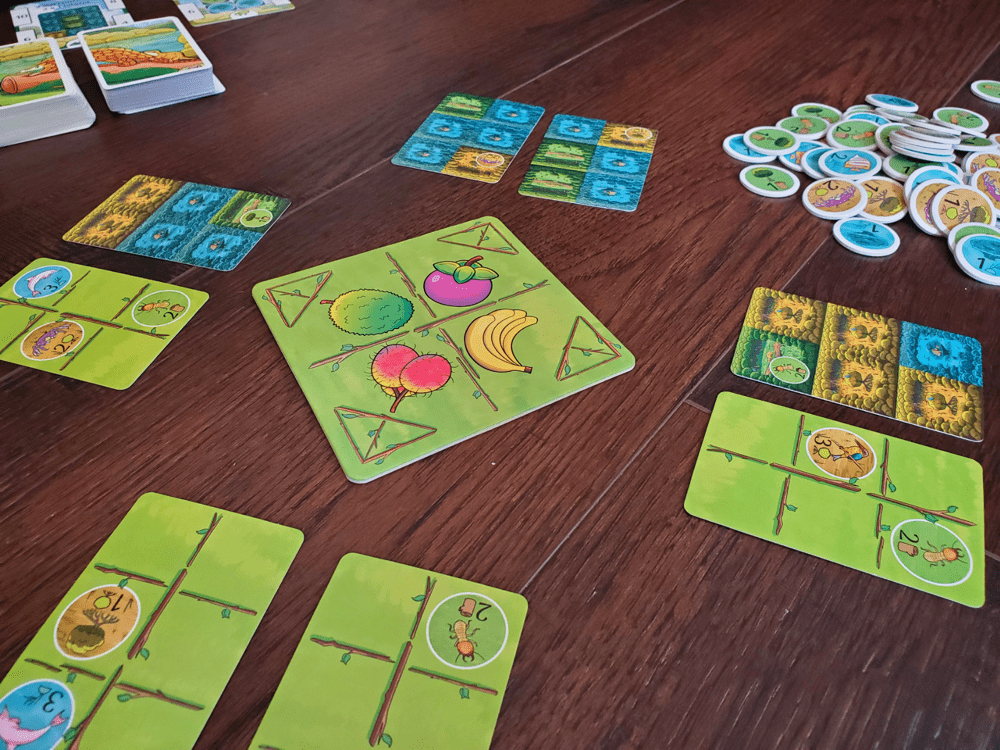
On each turn, the active player will set the Fruit dial to the pair of cards of the greatest interest, claiming them for their landscape. Once placed, the dial will direct each other player to one of the pairs, from which they must select only one of the cards.
Terrain cards are simply added to the ever-expanding landscape. Some terrain squares may grant a free Flora or Fauna token, which is then added to the corresponding space. Some Terrain squares feature a house which, when placed, causes the removal of one specific token from the landscape (unless such a token is not available to be discarded).
Flora and Fauna cards are also broken into a grid of six with certain squares picturing specific Flora and Fauna. Players use these cards to orient the placement of tokens into their landscape. Once placed, these cards are discarded. If a token cannot be placed, either because the location is off the map or because it does not match the Terrain required, it is set aside into the player’s Compost pile. Also, if a token can fitly replace another token, the replaced token must be removed to the Compost. Composted tokens will be penalized at the end of the game.

In each landscape, players attempt to build as complete a network of habitats as possible. Flora tokens are marked with a one, herbivores with a two, and carnivores with a three—indicating both their type and their point value. A well-formed habitat will feature all three links in the food chain, in equal proportion. If at the game’s end a token is isolated or not supported by the lower levels, it will not score. As a final restriction, Flora and Fauna directly adjacent to a house will incur a penalty.
Rainforest City includes a series of Objective cards, three of which can be played in a single game to introduce specific goals related to Terrain, Flora, and Fauna. Players mark these cards with their Fruit tokens as they are achieved, with higher bonuses going to those who accomplish the Objectives first.
After twelve total turns, the game ends. Properly supported Flora and Fauna receive their point values. Houses count for three points (but issue the aforementioned penalties based on the surrounding tokens). Objectives grant their boons and the player with the most successful landscape is declared the winner.
What you otter try
Rainforest City scales relatively well with two, three, or four players since the game is always based on twelve total turns. The only difference is the number of times each player will be given charge of the Fruit dial. If players are interested in a longer outing, I’ve found it quite reasonable to simply play until the Terrain cards run out rather than imposing the strict turn limit.
Origame has included a co-operative variant that removes scoring altogether in favor of chasing Objectives. Players each receive a Terrain, Flora, and Fauna Objective with the aim being the accomplishment of a specific number of goals. Players still build their own landscape, and each player must work on their own tasks. In this case, victory comes at a specific number of Objectives based on the player count, and defeat descends when one player loses five or more unmatching tokens to the Compost.
Solo play follows the co-operative model, but the player manages two landscapes simultaneously while seeking after specific Objectives. The target win and loss conditions vary based on the desired difficulty.
What you otter consider
There is no sense denying or ignoring the surface similarities here to recent Spiel des Jahres winner, Cascadia—gather paired Terrains and Tokens to build a landscape that meets a specific spatial criteria for scoring. The echoes are undeniable. Swap out the hexes for gridded cards, introduce a food chain instead of an array of animal configurations and you’ve successfully traveled the few thousand miles from the Northwestern US to Singapore for a second-cousin proposition. But there’s also no sense in evaluating Rainforest City solely according to its comparative status. I’d hold them as like-minded titles in the same genre, but still apples and oranges overall. Perhaps Chiku and Mangosteen would be the more apt comparison.
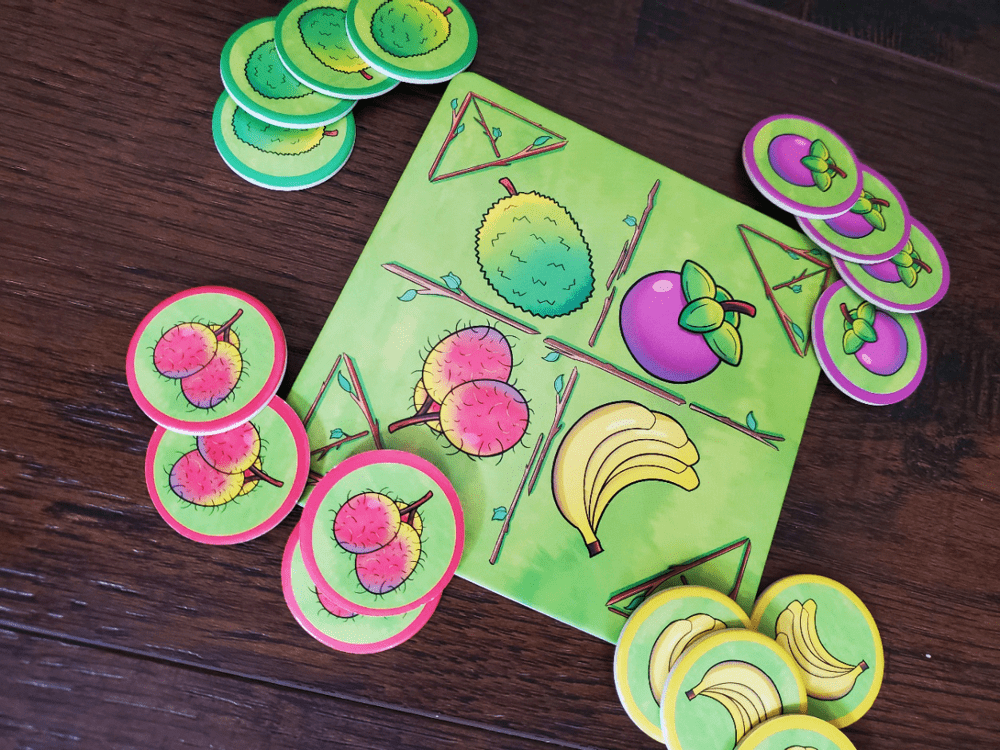
That out of the way, I have two wildly divergent thoughts about Rainforest City.
With regard to aesthetics, Rainforest City is a bit of a mess. The greatest offender here is the Mangrove Terrain, which is listed in the literature as brown. On the cards, however, it is a faded yellow-green that is nearly indistinguishable from the Rainforest terrain at a glance. The pattern of the two Terrains is likewise similar such that the entire game is spent casting double-takes to make sure you’re looking at the correct squares.
Only slightly less annoying are the houses, which are meant to exist independent of any one Terrain type, yet they feature the same border pattern and a color that is only slightly less yellow-green than that of the Mangrove. In a world that knows and loves video games like Minecraft, Stardew Valley, and Terraria (and their tabletop counterparts), there are abundant examples of how to place blocks of colored terrain side-by-side without confusion. I have to think the issue is a combination of a poorly chosen pattern and an unfortunate mistranslation between the design screen and the printer.
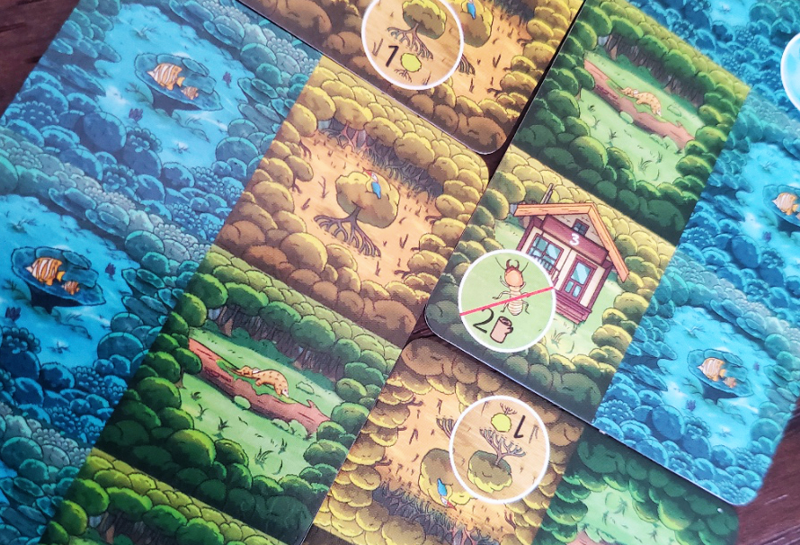
But on a more cheery note, the cards are wonderfully textured with a scaly design that feels lovely in the hand! The tokens are sturdy enough to bear the amount of handling that comes with the game. If not for the artistic hiccup, I might be saying even more great things about this small box.
With regard to gameplay, Rainforest City is a delightful puzzle. I am a fan of the decision space surrounding the Fruit dial. I respect games that cut into downtime by creating table scraps for the other players without going full bore into simultaneous play. Daryl Chow has also employed this concept beautifully in Wok and Roll. The dial means everyone is attentive and most often thinking and working, but also that there is significance in being the active player.
Building the landscape is breezy at first. Void of Flora and Fauna, every placement seems workable. As the game rolls forward, however, the placement of those precious tokens grows increasingly difficult. Nobody wants to Compost the poor little Kingfisher or the Pangolin, but there are sacrifices to be made on the way to a more fulfilling habitat. Every Flora will score, so why not simply fill the ground? Well, haste makes waste when the more lucrative Otters are ready to settle down and make a home at the expense of those thoughtlessly scattered seeds. Composting is costly in the long run. Rather than simply filling space, Rainforest City captures the notion of filling space wisely and with targeted diversity.
The Objective cards bring the right amount of tension. The best landscape in the world can’t overcome a willful defiance toward the almighty Objective. You simply can’t allow Ms Banana to score upwards of thirty bonus points while you, Mr Durian, score none. Personally, I welcome a little speed bump for the best laid plans that might force a long run of Mangroves through the heart of your Rainforest, or the creation of an island where you would otherwise prefer strictly Water. These pestering goals keep the game interesting.
Rainforest City brings one more dimension to the table with winsome clarity: the situational moment in Singapore. This is a regional game in that the chosen habitats, inhabitants, and even fruits are very real and geographically specific. The game carries an important message without obnoxious dissonance.

With regard to tone, I am reminded of Power Failure, the 2021 release from Artana that effectively places players in the conundrum of providing power responsibly to an urban population base. No particular ideological solution is proffered, but the quandary is made ever clearer. Here in Rainforest City, I get the same feelings. The idea is not to evict the humans and tout the eternal rise of the Otter. But there are consequences to the interaction of man and nature, and they are reflected in the play and in the score. If Daryl Chow’s aim was curiosity and awareness, mission accomplished. I enjoyed reading the supplemental info about the specific plants and animals in the game. The game’s exploration of human consequence makes the puzzle all the more engaging.
Overall, Rainforest City is solid and accessible fun that sets up and tears down easily (as long as you’re not particular about separating the 174 Flora and Fauna tokens) and lasts the promised thirty minutes. The theme is endearing and bears an appealing cultural gravity. The mechanics are interesting and engrossing with hardly any downtime. If not for the blatant design and color management issues, I would be more confident of its widespread appeal.
I won’t call it lightning by any means, but there’s a lot to enjoy and a worthy cause to meet in the exploration of this landscape. And I’m still quite happy to explore the next Daryl Chow title.


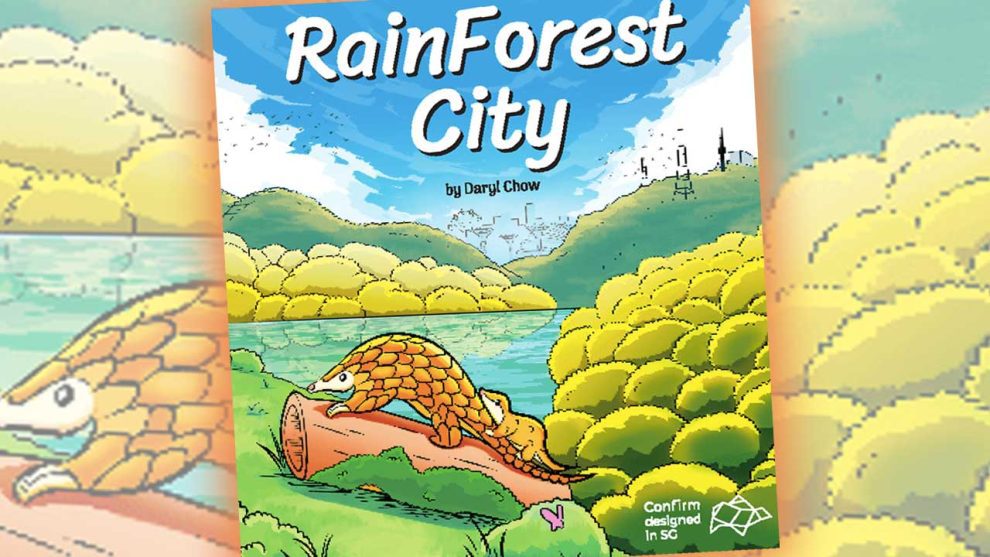
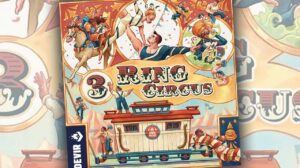

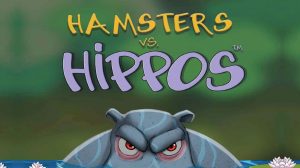





Add Comment